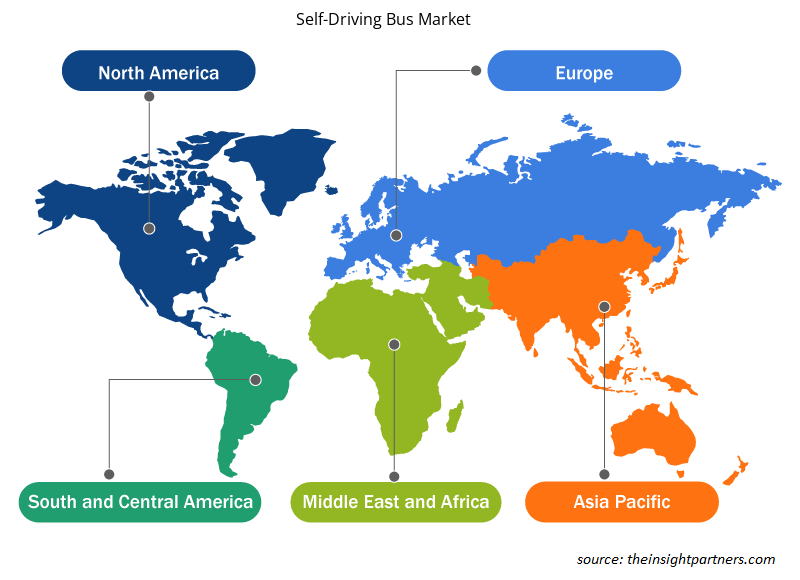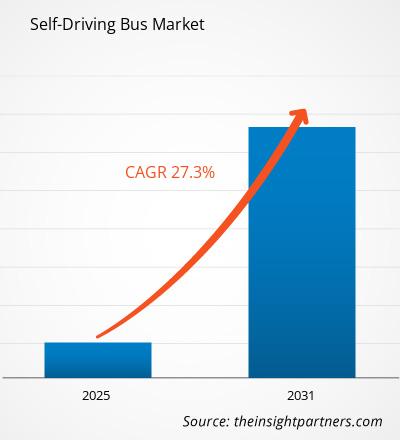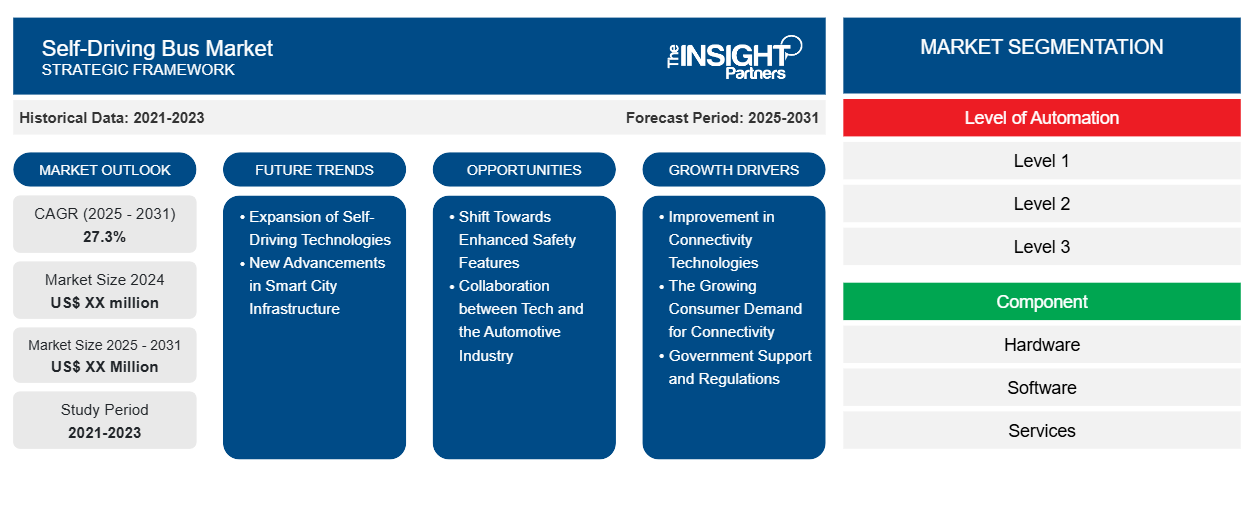من المتوقع أن يسجل سوق الحافلات ذاتية القيادة معدل نمو سنوي مركب بنسبة 27.3٪ من عام 2023 إلى عام 2031، مع توسع حجم السوق من XX مليون دولار أمريكي في عام 2023 إلى XX مليون دولار أمريكي بحلول عام 2031.
تم تقسيم التقرير حسب مستوى الأتمتة (المستوى 1، المستوى 2، المستوى 3، المستوى 4، المستوى 5)؛ والمكون (الأجهزة والبرامج والخدمات). كما تم تقسيم التحليل العالمي إلى مستويات إقليمية ودول رئيسية. ويقدم التقرير القيمة بالدولار الأمريكي للتحليل والقطاعات المذكورة أعلاه.
غرض التقرير
يهدف تقرير سوق الحافلات ذاتية القيادة الصادر عن The Insight Partners إلى وصف المشهد الحالي والنمو المستقبلي وأهم العوامل الدافعة والتحديات والفرص. وسيوفر هذا رؤى لمختلف أصحاب المصلحة في الأعمال التجارية، مثل:
- مزودي/مصنعي التكنولوجيا: لفهم ديناميكيات السوق المتطورة ومعرفة فرص النمو المحتملة، وتمكينهم من اتخاذ قرارات استراتيجية مستنيرة.
- المستثمرون: إجراء تحليل شامل للاتجاهات فيما يتعلق بمعدل نمو السوق، وتوقعات السوق المالية، والفرص المتاحة عبر سلسلة القيمة.
- الهيئات التنظيمية: لتنظيم السياسات ومراقبة الأنشطة في السوق بهدف تقليل الانتهاكات والحفاظ على ثقة المستثمرين والحفاظ على سلامة السوق واستقرارها.
تجزئة سوق الحافلات ذاتية القيادة
مستوى الأتمتة
- المستوى 1
- المستوى الثاني
- المستوى 3
- المستوى الرابع
- المستوى 5
عنصر
- الأجهزة
- برمجة
- خدمات
قم بتخصيص هذا التقرير ليناسب متطلباتك
ستحصل على تخصيص لأي تقرير - مجانًا - بما في ذلك أجزاء من هذا التقرير، أو تحليل على مستوى الدولة، وحزمة بيانات Excel، بالإضافة إلى الاستفادة من العروض والخصومات الرائعة للشركات الناشئة والجامعات
- احصل على أهم اتجاهات السوق الرئيسية لهذا التقرير.ستتضمن هذه العينة المجانية تحليلاً للبيانات، بدءًا من اتجاهات السوق وحتى التقديرات والتوقعات.
عوامل نمو سوق الحافلات ذاتية القيادة
- التحسن في تقنيات الاتصال: إن النمو في سوق الحافلات ذاتية القيادة مدفوع بالتقدم السريع في تقنيات الاتصال، بما في ذلك شبكات 4G وLTE، والتي ستتبعها قريبًا شبكات 5G. تسمح هذه التحسينات للمركبات بالتواصل مع بعضها البعض ومع البنية التحتية من أجل الحصول على تجربة قيادة أفضل، وضمان السلامة، والتنقل على الطرق.
- الطلب المتزايد من جانب المستهلكين على الاتصال: هناك اتجاه متزايد لتفضيل المستهلكين للمركبات المزودة بتقنيات الاتصال. وقد اكتسبت المركبات المجهزة بخيارات اتصال عالية قبولاً واسع النطاق بين العملاء. ومن الواضح أن السائقين يبحثون عن حلول الترفيه والملاحة والسلامة داخل المركبات والتي تعتمد على البيانات في الوقت الفعلي والاتصال بالإنترنت.
- الدعم الحكومي واللوائح التنظيمية: تستثمر العديد من الحكومات في جميع أنحاء العالم في مبادرات المدن الذكية وتقدم لوائح تنظيمية مواتية لدعم المركبات ذاتية القيادة. تعمل السياسات التي تخلق بيئة مواتية للابتكار، وخاصة في تكنولوجيات النقل والحافلات ذاتية القيادة، على تعزيز نمو السوق وتعزيز البنية الأساسية للحلول ذاتية القيادة.
اتجاهات مستقبل سوق الحافلات ذاتية القيادة
- التوسع في تكنولوجيات القيادة الذاتية: إن الجمع بين تكنولوجيات المركبات المتصلة وأنظمة القيادة الذاتية من شأنه أن يفتح الباب أمام فرص جديدة. ومع بدء الصناعة في دخول المركبات ذاتية القيادة بالكامل، ستكون هناك حاجة متزايدة إلى حلول اتصال جيدة. وهذا من شأنه أن يمكّن من توفير أوقات سفر أكثر أمانًا وكفاءة. ويمكن للمنظمات التي تستثمر في هذا المجال أن تستفيد من الاتجاه المتصاعد بسرعة نحو الأتمتة.
- التطورات الجديدة في البنية الأساسية للمدن الذكية: تعد الحافلات المتصلة المدينة بفرص مشرقة في التفاعل مع البنية الأساسية الحضرية. وتشمل هذه البنية الأساسية أنظمة إدارة المرور وحلول مواقف السيارات وشبكات النقل لمركبات الطرق العامة. وقد يؤدي التعاون بين مصنعي السيارات ومخططي المدن إلى حلول جديدة تهدف إلى جعل التنقل للأشخاص في المدينة أفضل وأقل ازدحامًا.
فرص سوق الحافلات ذاتية القيادة
- التحول نحو ميزات السلامة المحسنة: اتجاهات ميزات السلامة الأفضل - زيادة التخلص من حلول السلامة المتقدمة في المركبات المتصلة تعد ميزات السلامة المحسنة اتجاهًا مطلقًا. أصبحت أنظمة تجنب الاصطدام وظروف المرور في الوقت الفعلي وقدرات الاستجابة للطوارئ تركيبات قياسية تلقائيًا في النماذج الجديدة. سيضمن هذا الامتثال الأفضل للتنظيم ومخاوف المستهلكين، مما يؤدي إلى تبني أوسع نطاقًا للتكنولوجيات المتصلة.
- التعاون بين التكنولوجيا وصناعة السيارات: هناك اتجاه متزايد للتعاون بين شركات التكنولوجيا ومصنعي السيارات لتطوير أنظمة القيادة الذاتية للحافلات. تعمل شركات مثل Waymo وTesla ومصنعي الحافلات التقليديين معًا لتسريع نشر الحافلات ذاتية القيادة ودفع حدود أتمتة المركبات.
رؤى إقليمية حول سوق الحافلات ذاتية القيادة
لقد قام المحللون في Insight Partners بشرح الاتجاهات والعوامل الإقليمية المؤثرة على سوق الحافلات ذاتية القيادة طوال فترة التوقعات بشكل شامل. يناقش هذا القسم أيضًا قطاعات سوق الحافلات ذاتية القيادة والجغرافيا في جميع أنحاء أمريكا الشمالية وأوروبا ومنطقة آسيا والمحيط الهادئ والشرق الأوسط وأفريقيا وأمريكا الجنوبية والوسطى.

- احصل على البيانات الإقليمية المحددة لسوق الحافلات ذاتية القيادة
نطاق تقرير سوق الحافلات ذاتية القيادة
| سمة التقرير | تفاصيل |
|---|---|
| حجم السوق في عام 2023 | XX مليون دولار أمريكي |
| حجم السوق بحلول عام 2031 | XX مليون دولار أمريكي |
| معدل النمو السنوي المركب العالمي (2023 - 2031) | 27.3% |
| البيانات التاريخية | 2021-2022 |
| فترة التنبؤ | 2024-2031 |
| القطاعات المغطاة | حسب مستوى الأتمتة
|
| المناطق والدول المغطاة | أمريكا الشمالية
|
| قادة السوق وملفات تعريف الشركات الرئيسية |
|
كثافة اللاعبين في سوق الحافلات ذاتية القيادة: فهم تأثيرها على ديناميكيات الأعمال
يشهد سوق الحافلات ذاتية القيادة نموًا سريعًا، مدفوعًا بالطلب المتزايد من المستخدم النهائي بسبب عوامل مثل تفضيلات المستهلكين المتطورة والتقدم التكنولوجي والوعي المتزايد بفوائد المنتج. ومع ارتفاع الطلب، تعمل الشركات على توسيع عروضها والابتكار لتلبية احتياجات المستهلكين والاستفادة من الاتجاهات الناشئة، مما يؤدي إلى زيادة نمو السوق.
تشير كثافة اللاعبين في السوق إلى توزيع الشركات أو المؤسسات العاملة في سوق أو صناعة معينة. وهي تشير إلى عدد المنافسين (اللاعبين في السوق) الموجودين في مساحة سوق معينة نسبة إلى حجمها أو قيمتها السوقية الإجمالية.
الشركات الرئيسية العاملة في سوق الحافلات ذاتية القيادة هي:
- شركة أيه بي فولفو
- أنظمة ليلي
- شركة دايملر ايه جي
- شركة هينو موتورز المحدودة
- ايزي مايل
إخلاء المسؤولية : الشركات المذكورة أعلاه ليست مرتبة بأي ترتيب معين.

- احصل على نظرة عامة على أهم اللاعبين الرئيسيين في سوق الحافلات ذاتية القيادة
نقاط البيع الرئيسية
- التغطية الشاملة: يغطي التقرير بشكل شامل تحليل المنتجات والخدمات والأنواع والمستخدمين النهائيين لسوق الحافلات ذاتية القيادة، مما يوفر صورة شاملة.
- تحليل الخبراء: تم تجميع التقرير على أساس الفهم العميق لخبراء الصناعة والمحللين.
- معلومات محدثة: يضمن التقرير أهمية الأعمال التجارية بسبب تغطيته للمعلومات الحديثة واتجاهات البيانات.
- خيارات التخصيص: يمكن تخصيص هذا التقرير لتلبية متطلبات العملاء المحددة وبما يتناسب مع استراتيجيات العمل بشكل مناسب.
وبالتالي، فإن تقرير البحث حول سوق الحافلات ذاتية القيادة يمكن أن يساعد في تمهيد الطريق لفك شفرة وفهم سيناريو الصناعة وآفاق النمو. ورغم وجود بعض المخاوف المشروعة، فإن الفوائد الإجمالية لهذا التقرير تميل إلى التفوق على العيوب.
- التحليل التاريخي (سنتان)، سنة الأساس، التوقعات (7 سنوات) مع معدل النمو السنوي المركب
- تحليل PEST و SWOT
- حجم السوق والقيمة / الحجم - عالمي، إقليمي، بلد
- الصناعة والمنافسة
- مجموعة بيانات إكسل
التقارير الحديثة
شهادات العملاء
سبب الشراء
- اتخاذ قرارات مدروسة
- فهم ديناميكيات السوق
- تحليل المنافسة
- رؤى العملاء
- توقعات السوق
- تخفيف المخاطر
- التخطيط الاستراتيجي
- مبررات الاستثمار
- تحديد الأسواق الناشئة
- تحسين استراتيجيات التسويق
- تعزيز الكفاءة التشغيلية
- مواكبة التوجهات التنظيمية





















 احصل على عينة مجانية ل - سوق الحافلات ذاتية القيادة
احصل على عينة مجانية ل - سوق الحافلات ذاتية القيادة